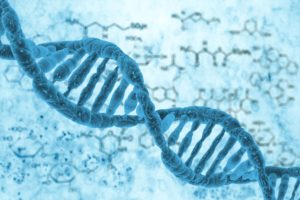



DNA encoded libraries (DEL) have received a lot of attention over the past few years. They’ve been hailed as “highly attractive technology for the discovery of small molecule protein ligands” and represent an important new approach for chemical screening. As the name suggests, each molecule in a DNA-encoded library is labeled with a DNA tag [Figure 1]. And as part of a chemical screen of a protein target, it is therefore possible to determine molecules that bind to the protein using PCR amplification and next generation sequencing.
DEL technology allows the scale of chemical screening to be increased orders of magnitude beyond conventional high-throughput libraries. Large high-throughput libraries are employed in pharmaceutical companies at a scale of roughly a few million compounds, involving a large investment in automation technology, robotics etc. In contrast, the DEL field now boasts libraries that consist out of hundreds of billions of molecules. Amazingly, an entire library of that dimension can be contained in a single Eppendorf tube.
Pharma is recognizing the benefits of DEL and Amgen recently paid $167 million for Nuevolution’s platform along with a pipeline of early-stage cancer and inflammation programs. We are starting to see compounds derived from DEL enter early clinical candidates. An epoxide hydrolase inhibitor identified during a proof-of-concept studies of an encoded library technology platform has entered Phase I clinical trials as a potential drug for cardiovascular and respiratory conditions, whilst a series of inhibitors of receptor interacting protein 1 (RIP1) kinase have been reported for inflammation. The recent Amgen purchase also highlights a recent trend within pharma towards internalization of DEL efforts. Many companies that started using DEL technology with vendors have wound up starting their own proprietary internal programs to allow deeper access to this useful technology.
However, like any screening approach, DEL technology is not without its limitations. The breadth of chemistry possible with DEL is growing but still relatively limited. Given this, the focus to date has largely been around increasing the number of molecules in the library through additional cycles and monomer numbers. This leads to libraries that contain a lot of molecules but which do not in aggregate, survey significant chemical space. Despite a number of successes with DEL, one frequent complaint is that DEL molecules often are large molecules, contain several rotatable bonds (making them “floppy”) and behave non-drug like in other properties. A recent analysis of starting points in drug discovery by Young and Leeson illustrates this problem [Figure 2]. The physical property profile of published DEL hits (labeled DNA-ELT leads) is at the top right.

We have grown accustomed to thinking differently at HotSpot and this has led us to a very different application of DEL in the context of natural regulatory sites.
Rather than focusing on developing the largest libraries, we are creating focused chemical collections designed explicitly for regulatory hotspots within specific target classes.
Our SpotFinder™ platform identifies potential allosteric regulatory pockets in proteins. In doing so, we have created an annotated pocketome that highlights pockets with similar function and topology across a target class. This allows us to create consensus pockets: three-dimensional representations of the features that are shared and distinct within allosteric regulatory pockets [Figure 3].

Consensus pockets provide a roadmap for the design of customized chemical collections. Hotspot-tailored chemistries and monomers have been designed that optimally display desired pharmacophoric features. In the world of DNA-encoded libraries, this allows us to rapidly generate millions of tailored molecules in a matter of months. We have observed that tailored libraries drive hit rates and the overall quality of the chemical matter.
Experienced DEL practitioners know that great skill is required to present the protein in the right form to the library. Many cycles of assay development may be necessary to optimize DEL output. Futhermore, many DEL screens are blind to the region of the protein of interest. At HotSpot, we have invested heavily in creating target proteins in different forms that present the designer allosteric site to the screening library optimally. Moreover, we have developed customized assays techniques that allow us to focus on a specific part of the protein, allosteric regulatory regions that our platform has prespecified.
Given the size of the libraries, DEL screening can generate many hits and it can be challenging to select those that merit following up. Armed with the rich structural information that enables all HotSpot programs, we are able to prioritize the compounds that are resynthesized through computational docking. This allows us to focus on the molecules that not only bind to our protein of interest, but bind to the regulatory hotspot within our protein of interest. This is a means of using the power of the speed and numbers of molecules that can be made with DNA-encoded library technology and focus the technology on one specific pocket. Upon learning what pharmacophore elements are important to families of regulatory hotspots, we can quickly turn this learning into scaffolds and monomer combinations, the combinations used to build DNA-encoded libraries.
Biotech company Macroceutics is a provider of DEL screening technologies, designed by a team focused on producing optimal drug-like molecules. Having been able to trial the Macroceutics platform, we were impressed by the small, drug like nature of Macroceutics libraries. The well-tailored DELs and a great working relationship, led to an enjoyable and successful initial collaboration. Bringing the Macroceutics team and technology in-house, we can fully leverage the technology, it was the natural next step. And now that hotspots have met DEL, we are looking forward to bringing our HotSpot pipeline onto the next level together with our new team members.